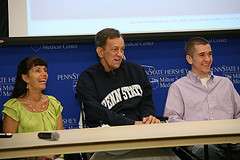Medical center performs rare, double living donor organ transplant

Transplant surgeons at Penn State Milton S. Hershey Medical Center recently performed their first simultaneous, dual living donor organ transplant on a single recipient. The recipient, a 60-year-old man from the Hazleton area, received a kidney from his wife and a section of his youngest son’s liver in a complicated surgery that lasted nearly 19 hours. Simultaneous transplants of multiple organs from multiple living donors to a single recipient are exceedingly rare in the United States; since 1987, the procedure has been performed with a liver and kidney coming from different living donors just 10 other times.
On March 15 following more than a year and a half of progressive illness that lead to cryptogenic cirrhosis of the liver, Timothy Bradbury, of New Boston, Pa., received a kidney from his wife, Mary Ellen Bradbury, 55, and the right lobe of the liver from his youngest son, James Bradbury, 19. The nature and severity of his illness meant Timothy Bradbury’s chances for getting two unrelated organ matches or two organs from a deceased donor in time were low.
“Timothy Bradbury suffered from end-stage liver disease thought to be congenital in origin and associated with progressive kidney failure,” said Dr. Zakiyah Kadry, chief of the division of transplant surgery and surgical director of liver transplantation. “His overall clinical condition had been deteriorating significantly, with severe fluid accumulation in the belly and extreme muscle wasting from a poor nutritional status secondary to his liver disease. Both of these complications are not well reflected by the MELD score, which is the scoring system used to decide a patient’s position on the national transplant waiting list.”
Because of this discrepancy, Timothy Bradbury’s risk of death on the waiting list was very high had he had to wait for a standard donor. A combined liver and kidney transplant was felt to be necessary, and several members of Timothy Bradbury’s family indicated they wished to donate.
“We opted to proceed with two separate donors rather than remove both the kidney and part of the liver from a single live donor to reduce the operative and long term donor risks,” Kadry said.
In a living donor liver transplant, a portion of the liver is obtained from a healthy donor -- in most cases a spouse, family member or close friend -- and transplanted into the recipient. The liver is the only organ in the body that can regenerate to normal function and size within approximately one to two months.
Timothy Bradbury’s new liver and kidney continue to perform well as he recovers from the transplant from his son and wife. Six weeks after the surgery, James Bradbury’s liver has regenerated to full size. He says he’s grateful he was able to donate to his father and give him a second chance.
“Everybody’s put on this planet for a reason, and maybe this is mine. In my heart, that’s why I feel I’m here -- to save my dad’s life,” James Bradbury said. “To other people out there who might be considering being an organ donor, I’d say don’t be afraid to take the chance and give something of yourself to help human kind.”
“This is something we all feel was meant to be,” Mary Ellen Bradbury said. “It’s going to take awhile for things to get back to normal, but everyone -- from the doctors and nurses here to the people back home where we live -- have been so amazing to us. There’s really no way to thank everyone for what went on here.”
In the United States, the demand for donor organs continues to exceed that of supply. Currently there are more than 16,000 patients registered on the United Network for Organ Sharing (UNOS) waiting list for a liver organ and only 6,000 to 6,500 liver transplants are being performed annually. In Pennsylvania, nearly 1,500 candidates are on the liver transplant waiting list. According to the UNOS database, between 1,500 and 2,000 candidates on the national liver transplant waiting list die each year while waiting for a liver organ. While living liver donor numbers are limited as donor safety is the primary concern, the procedure provides at least 200 to 300 additional liver transplants annually.
Penn State Hershey Medical Center has a rigorous multidisciplinary selection process to ensure the absolute safety of the donor and recipient. The Medical Center’s live donor liver transplant program is focused on specific categories of patients on the waiting list that have a higher-than-average risk of being unable to receive a liver transplant in a timely manner, such as blood group O recipients or patients with recurrent significant complications of their liver disease that place them at risk without improving their chances of receiving a liver transplant on the current liver allocation system.
Penn State Hershey Medical Center is UNOS-certified for live donor liver transplantation. Kadry leads an interdisciplinary team of transplant surgeons, anesthesiologists, hepatologists, pre- and post-transplant coordinators, nurses, social workers, transplant pharmacists and nutritionists who are all actively involved in transplant patients’ care.















